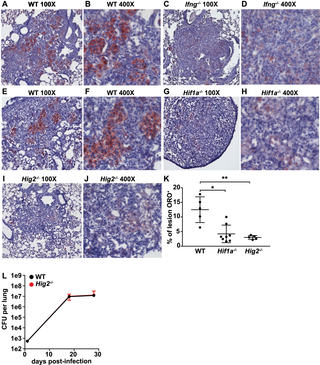PLoS Pathogens ( IF 5.5 ) Pub Date : 2018-01-25 , DOI: 10.1371/journal.ppat.1006874 Matthew Knight , Jonathan Braverman , Kaleb Asfaha , Karsten Gronert , Sarah Stanley

|
Lipid droplet (LD) formation occurs during infection of macrophages with numerous intracellular pathogens, including Mycobacterium tuberculosis. It is believed that M. tuberculosis and other bacteria specifically provoke LD formation as a pathogenic strategy in order to create a depot of host lipids for use as a carbon source to fuel intracellular growth. Here we show that LD formation is not a bacterially driven process during M. tuberculosis infection, but rather occurs as a result of immune activation of macrophages as part of a host defense mechanism. We show that an IFN-γ driven, HIF-1α dependent signaling pathway, previously implicated in host defense, redistributes macrophage lipids into LDs. Furthermore, we show that M. tuberculosis is able to acquire host lipids in the absence of LDs, but not in the presence of IFN-γ induced LDs. This result uncouples macrophage LD formation from bacterial acquisition of host lipids. In addition, we show that IFN-γ driven LD formation supports the production of host protective eicosanoids including PGE2 and LXB4. Finally, we demonstrate that HIF-1α and its target gene Hig2 are required for the majority of LD formation in the lungs of mice infected with M. tuberculosis, thus demonstrating that immune activation provides the primary stimulus for LD formation in vivo. Taken together our data demonstrate that macrophage LD formation is a host-driven component of the adaptive immune response to M. tuberculosis, and suggest that macrophage LDs are not an important source of nutrients for M. tuberculosis.
中文翻译:

结核分枝杆菌感染的巨噬细胞中的脂滴形成需要IFN-γ/HIF-1α信号传导并支持宿主防御
在巨噬细胞感染多种细胞内病原体(包括结核分枝杆菌)的过程中,会发生脂质滴(LD)形成。据信,中号。结核病和其他细菌特别引起LD的形成是一种致病策略,目的是建立宿主脂质的贮库,以用作碳源来促进细胞内生长。在这里,我们显示LD的形成不是M期间的细菌驱动过程。结核感染,而是作为宿主防御机制一部分的巨噬细胞免疫激活而发生的。我们显示,以前牵涉到宿主防御中,由IFN-γ驱动的HIF-1α依赖性信号通路将巨噬细胞脂质重新分布到LDs中。此外,我们表明,中号。在没有LDs的情况下,结核病能够获得宿主脂质,但在IFN-γ诱导的LDs的存在下,结核病能够获得宿主脂质。该结果使巨噬细胞LD的形成与宿主脂质的细菌获取脱钩。此外,我们表明,IFN-γ驱动的LD形成支持宿主保护性类花生酸的生产,包括PGE 2和LXB 4。最后,我们证明了HIF-1α及其靶基因Hig2是感染M的小鼠肺中大部分LD形成所需要的。结核病,因此表明免疫激活提供了体内LD形成的主要刺激因子。综合我们的数据表明,巨噬细胞LD形成是宿主对M的适应性免疫反应的驱动因素。结核病,并提示巨噬细胞LDs不是M的重要营养来源。肺结核。


















































 京公网安备 11010802027423号
京公网安备 11010802027423号